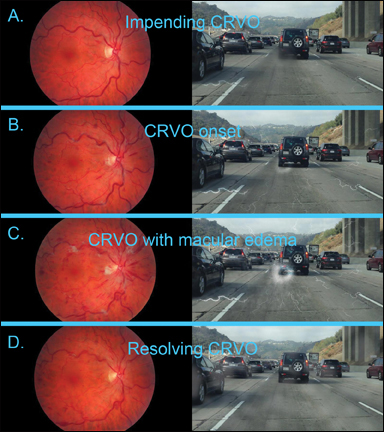What does the patient see?
It can be hard for the ophthalmologist to understand what visual symptoms are seen by the patient.
Click Here to Manage Email Alerts
When we examine patients, we are looking at their eyes and their pathologies from the outside seeing in. We can get some idea as to the visual obscuration caused by a cataract by seeing how our view of the retina is distorted when looking through it. But this may not accurately reflect what the patient actually sees. With retinal disease, it is even more difficult to understand what visual symptoms are seen by the patient.
Some famous artists were known to have ocular pathology: Claude Monet suffered from cataracts and Edgar Degas likely had a form of macular degeneration. These conditions significantly affected the work of these artists, and when looking at a timeline of their work, we can see progressive deterioration of details, colors and forms.
Patient with nuclear cataracts
Recently, I had two patients who have experience in graphic arts and computer simulations, and each made me photographs to show the effect of their ocular conditions.
The first patient had moderate nuclear cataracts that decreased her visual acuity to 20/50. What was most striking is that measuring Snellen letters, which are high contrast and monochrome, did not accurately reflect the full decline in the patient’s vision. The most noticeable change was the color spectrum and the transmission of certain hues, particularly blues and whites.

Figure 1.A patient with experience in graphic arts and computer simulations created these pictures to show the difference between before and after cataract surgery.
Source: Devgan U

Figure 2. This patient is a visual artist who created simulations of his vision at different time points. The first frame (a) shows his initial symptoms when he was diagnosed with a CRVO. As the CRVO progresses (b) and induces macular edema (c), his symptoms become more pronounced. Finally, as the CRVO resolves (d), the patient is left with splotchy patches in his vision, which are slowly resolving.
In the before and after photos (Figure 1), the contrast was improved after surgery with a greater separation between light and dark. The patient also subjectively reported that she now uses less light in her home to do the same tasks and that in particularly challenging situations, such as walking into a dark room at night, she is now able to see sufficiently to navigate.
Because the effect of the cataract is so much more than just Snellen acuity, should we be doing other types of preoperative testing to determine visual impairment? While some use an arbitrary cut-off such as 20/50 vision or worse to determine the need for cataract surgery, these patient-generated figures suggest that we should look at functional visual needs such as contrast and colors as well.
Patient with CRVO
The effect of retinal disease on a patient’s vision can be more challenging to understand than that of cataracts. In the case here, a healthy 45-year-old patient with no medical or ocular history presented with a complaint of seeing a persistent lightning bolt in part of his vision with some slight smearing in a few spots of his central vision. He still read 20/20 on the Snellen chart.
Examination showed an impending central retinal vein occlusion (Figure 2a) with tortuous vessels and a slowed vascular transit time as seen on fluorescein angiography. As the disease process progressed into a partial CRVO, the patient noted more symptoms: more prominence to the lightning bolt shapes, which corresponded to retinal vasculature, as well as deterioration of the central vision to 20/25 (Figure 2b) and then to 20/40 (Figure 2c) as macular edema set in.
This patient was fortunate that the vein occlusion and macular edema resolved quickly without the need for intravitreal injections. But even after 8 weeks of healing, there were still some persistent visual changes such as splotchy patches and diminished contrast even though the Snellen acuity returned to 20/20.
Studying these patient-made simulations can help us understand what patients with various ocular pathologies are actually seeing and how visual symptoms affect their lives.
Reference:
Marmor MF. Arch Ophthalmol. 2006;doi:10.1001/archopht.124.12.1764.For more information:
Uday Devgan, MD, is in private practice at Devgan Eye Surgery and Chief of Ophthalmology at Olive View UCLA Medical Center. He can be reached at 11600 Wilshire Blvd. #200, Los Angeles, CA 90025; 800-337-1969; email: devgan@gmail.com; website: www.DevganEye.com.Disclosure: Devgan has no relevant financial disclosures.
